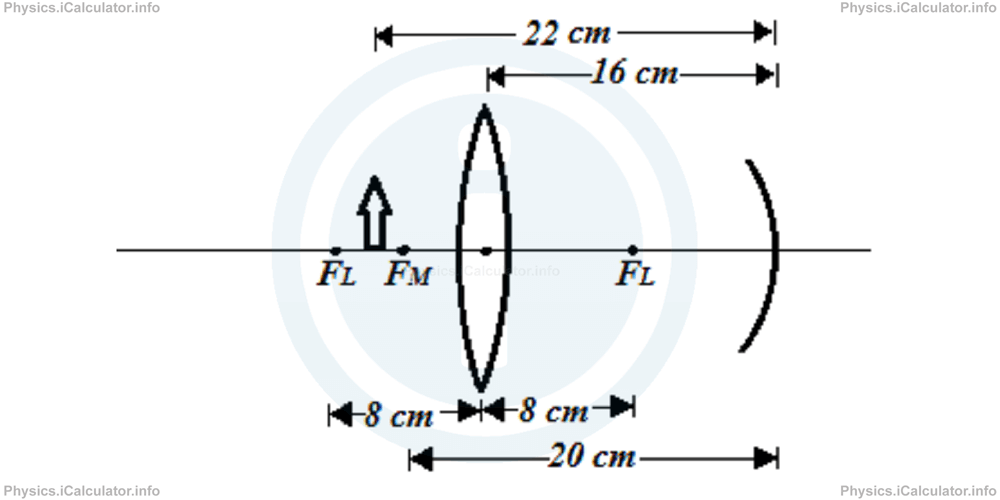Menu
Physics Lesson 12.9.8 - Combined Systems of Lenses and Curved Mirrors
Please provide a rating, it takes seconds and helps us to keep this resource free for all to use
Welcome to our Physics lesson on Combined Systems of Lenses and Curved Mirrors, this is the eighth lesson of our suite of physics lessons covering the topic of Lenses. Equation of Lenses. Image Formation of Lenses, you can find links to the other lessons within this tutorial and access additional physics learning resources below this lesson.
Combined Systems of Lenses and Curved Mirrors
We can combine optical tools such as plane and curved mirror with lenses to produce new optical systems, like we did in the previous tutorial where two curved mirrors were combined to produce new images. Let's see an example in this regard.
Example 3
An optical magnifying device is composed by a converging lens and a concave mirror as shown in the figure.

What is the total magnification produced by this optical system if the object is placed at the distance shown?
Solution 3
First, let's calculate the position of the image produced by the converging lens. From the figure, we can extract the following clues:
FL = 8 cm
dî = ?
Applying the equation
we obtain
1/dî = 1/8 - 1/6
= 3/24 - 4/24
= - 1/24
This means the image produced by the converging lens is 24 cm on its left. Thus, the magnification produced by the converging lens is
= - 24/6
= - 4
This means the image produced by the converging lens is 4 times larger than the object.
This image acts as an object for the concave mirror. Its distance from the mirror is
F = 20 cm
dî = ?
We have:
1/40 + 1/dî = 1/20
1/dî = 1/20 - 1/40
= 2/40 - 1/40
= 1/40
Thus, the second image is 40 cm on the left of the converging lens. In this case, there is no magnification as
= 40/40
= 1
Thus, the mirror is used only to turn the image upright.
Therefore, the total magnification produced by this system is
= - 4 × 1
= - 4
This means the final image is 4 times larger than the object.
You have reached the end of Physics lesson 12.9.8 Combined Systems of Lenses and Curved Mirrors. There are 8 lessons in this physics tutorial covering Lenses. Equation of Lenses. Image Formation of Lenses, you can access all the lessons from this tutorial below.
More Lenses. Equation of Lenses. Image Formation of Lenses Lessons and Learning Resources
Whats next?
Enjoy the "Combined Systems of Lenses and Curved Mirrors" physics lesson? People who liked the "Lenses. Equation of Lenses. Image Formation of Lenses lesson found the following resources useful:
- Combined Feedback. Helps other - Leave a rating for this combined (see below)
- Optics Physics tutorial: Lenses. Equation of Lenses. Image Formation of Lenses. Read the Lenses. Equation of Lenses. Image Formation of Lenses physics tutorial and build your physics knowledge of Optics
- Optics Revision Notes: Lenses. Equation of Lenses. Image Formation of Lenses. Print the notes so you can revise the key points covered in the physics tutorial for Lenses. Equation of Lenses. Image Formation of Lenses
- Optics Practice Questions: Lenses. Equation of Lenses. Image Formation of Lenses. Test and improve your knowledge of Lenses. Equation of Lenses. Image Formation of Lenses with example questins and answers
- Check your calculations for Optics questions with our excellent Optics calculators which contain full equations and calculations clearly displayed line by line. See the Optics Calculators by iCalculator™ below.
- Continuing learning optics - read our next physics tutorial: Power of Lenses. The Human Eye
Help others Learning Physics just like you
Please provide a rating, it takes seconds and helps us to keep this resource free for all to use
We hope you found this Physics lesson "Lenses. Equation of Lenses. Image Formation of Lenses" useful. If you did it would be great if you could spare the time to rate this physics lesson (simply click on the number of stars that match your assessment of this physics learning aide) and/or share on social media, this helps us identify popular tutorials and calculators and expand our free learning resources to support our users around the world have free access to expand their knowledge of physics and other disciplines.